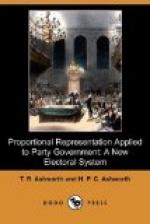The conclusion that must be reached from all these considerations is that, except when there is a single candidate standing in the interests of each of the two main parties, it is impossible to say with the present system who ought to be elected. The difficulty is one of fundamental principle. The only way to do justice to both parties is to enlarge the electorates so that each can get its proportionate share of representation, and then to provide such machinery as will allow each party separately to elect its most favoured candidates. In no other way can the people be induced to organize into two coherent parties.
CHAPTER X.
APPLICATION OF THE REFORM TO AUSTRALIAN LEGISLATURES.
+Federal Legislatures.+—The keynote of the Australian Federal Constitution, as expressed in the Commonwealth Bill, is full and unreserved trust in the people. This is in direct contrast with the American Constitution, which seeks to place checks on the people by dividing power among the President, the Senate, and the House of Representatives, and assigning to each separate functions. Do we fully realize the dangers as well as the glorious possibilities of unfettered action? Do we sufficiently feel the weight of the responsibility we have undertaken? In reality we have declared to the world the fitness of the Australian democracy to work a Constitution from which the most advanced of the other nations would shrink! We do not hesitate to avow our firm belief that there is only one thing that can save the situation. Unless Australia is to show to the world a warning instead of an example, all her energies must be bent on the formation of two coherent organized parties, dividing each State on national issues, and competing for the support of all classes and all interests in every electorate throughout the Commonwealth.




